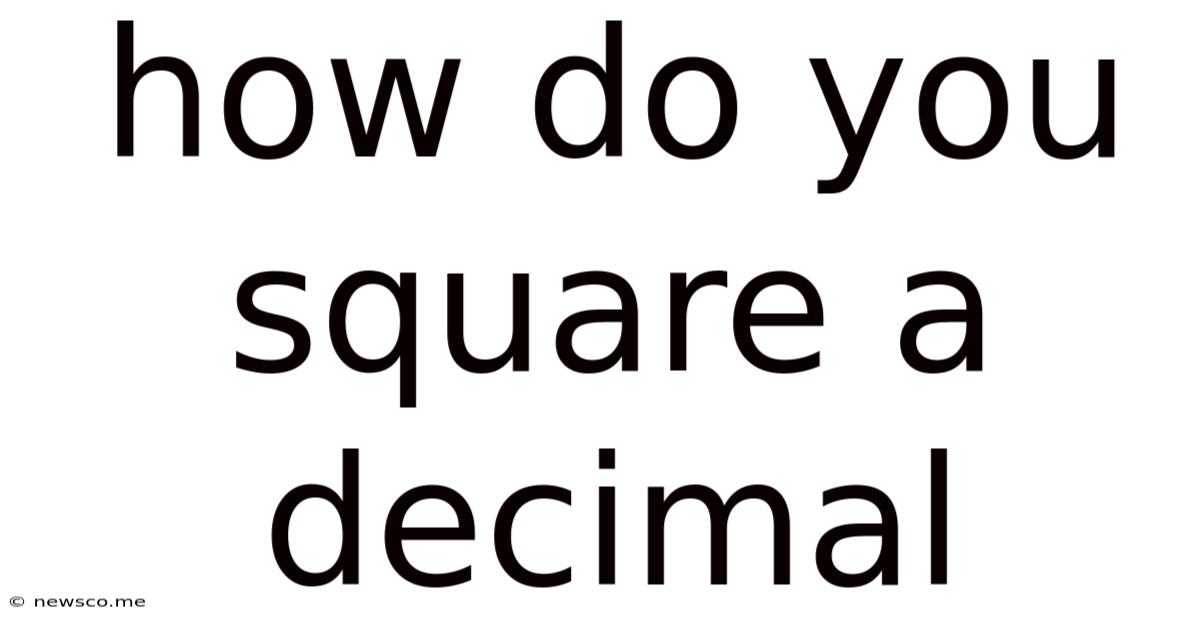How Do You Square A Decimal
News Co
May 07, 2025 · 4 min read

Table of Contents
How Do You Square a Decimal? A Comprehensive Guide
Squaring a decimal might seem daunting at first, but it's a straightforward process once you understand the underlying principles. This comprehensive guide will walk you through various methods, from the basics to more advanced techniques, ensuring you master squaring decimals with confidence. We'll also explore practical applications and tackle common misconceptions.
Understanding the Fundamentals: What Does Squaring Mean?
Before diving into decimals, let's solidify our understanding of squaring. Squaring a number means multiplying it by itself. For example, squaring 5 (written as 5²) means 5 * 5 = 25. This applies equally to decimals. Squaring a decimal, such as 0.5, means multiplying 0.5 by 0.5.
The Importance of Place Value
Understanding place value is crucial when working with decimals. Each digit in a decimal number represents a different power of 10. For example, in the number 0.123:
- 0: Represents the ones place (10⁰)
- 1: Represents the tenths place (10⁻¹)
- 2: Represents the hundredths place (10⁻²)
- 3: Represents the thousandths place (10⁻³)
Keeping this in mind helps with accuracy during calculations.
Method 1: Direct Multiplication
This is the most fundamental method. You multiply the decimal by itself using the standard multiplication method. Let's illustrate with an example:
Example: Square 0.7
- Write it out: 0.7 * 0.7
- Multiply as if they were whole numbers: Ignoring the decimal point initially, we have 7 * 7 = 49.
- Count decimal places: In the original numbers, 0.7 and 0.7, there's a total of two decimal places (one in each number).
- Add decimal point: Starting from the right, move the decimal point two places to the left in the result (49). This gives us 0.49.
Therefore, 0.7² = 0.49
Method 2: Converting to Fractions
This method involves converting the decimal to a fraction, squaring the fraction, and then converting the result back to a decimal. This method is particularly useful for certain decimals that have simple fractional equivalents.
Example: Square 0.25
- Convert to fraction: 0.25 is equivalent to ¼ (one-quarter).
- Square the fraction: (¼)² = ¼ * ¼ = 1/16
- Convert back to decimal: 1/16 = 0.0625
Therefore, 0.25² = 0.0625
Method 3: Using a Calculator
Calculators are a convenient tool for squaring decimals, especially when dealing with larger or more complex numbers. Most calculators have a square function (usually denoted by x²). Simply enter the decimal and press the square button.
Example: Square 3.14
- Enter the number: 3.14
- Press the square button (x²): The calculator will display the result: 9.8596
Therefore, 3.14² ≈ 9.8596
Method 4: Utilizing the Distributive Property (for specific cases)
The distributive property (a + b)² = a² + 2ab + b² can be helpful when squaring decimals close to whole numbers.
Example: Square 2.1
- Rewrite as a sum: 2.1 can be written as 2 + 0.1
- Apply the distributive property: (2 + 0.1)² = 2² + 2(2)(0.1) + 0.1² = 4 + 0.4 + 0.01 = 4.41
Therefore, 2.1² = 4.41
Advanced Techniques and Considerations
Squaring Decimals with Multiple Decimal Places
The process remains the same regardless of the number of decimal places. Just remember to accurately count the total number of decimal places in the original numbers before adding the decimal point to your answer.
Squaring Negative Decimals
Squaring a negative decimal results in a positive number. This is because a negative number multiplied by a negative number always yields a positive result. For example, (-0.5)² = 0.25
Dealing with Recurring Decimals
Squaring recurring decimals can be more complex. It often requires converting the recurring decimal into a fraction first, as demonstrated in Method 2, and then squaring the fraction.
Practical Applications of Squaring Decimals
Squaring decimals finds applications in various fields, including:
- Geometry: Calculating areas of squares and circles with decimal dimensions.
- Physics: Formulas involving squared distances or speeds often use decimals.
- Statistics: Calculating variance and standard deviation which involve squaring differences from the mean.
- Finance: Compound interest calculations.
Troubleshooting Common Mistakes
- Incorrect decimal placement: Double-check the number of decimal places in your calculations. A misplaced decimal point significantly impacts the accuracy of the result.
- Misinterpreting negative numbers: Remember that squaring a negative number always results in a positive number.
- Arithmetic errors: Carefully review each step of your multiplication to avoid errors.
Conclusion
Squaring decimals is a fundamental mathematical skill with various practical applications. Mastering this skill requires a solid understanding of place value, decimal multiplication, and potentially the use of fractions. By utilizing the methods outlined in this guide and paying close attention to detail, you can confidently square any decimal number. Remember to check your work carefully to avoid common mistakes, and feel free to use a calculator for added assurance, especially when dealing with more complex numbers. Consistent practice is key to building fluency and accuracy in this essential mathematical operation.
Latest Posts
Latest Posts
-
1 5 On The Number Line
May 07, 2025
-
Each Set Of Place Value Blocks Below Represents A Decimal
May 07, 2025
-
Definition Of Congruent Circles In Geometry
May 07, 2025
-
If A Number Is Real Then It Is Also Rational
May 07, 2025
-
Simplify The Square Root Of 12
May 07, 2025
Related Post
Thank you for visiting our website which covers about How Do You Square A Decimal . We hope the information provided has been useful to you. Feel free to contact us if you have any questions or need further assistance. See you next time and don't miss to bookmark.